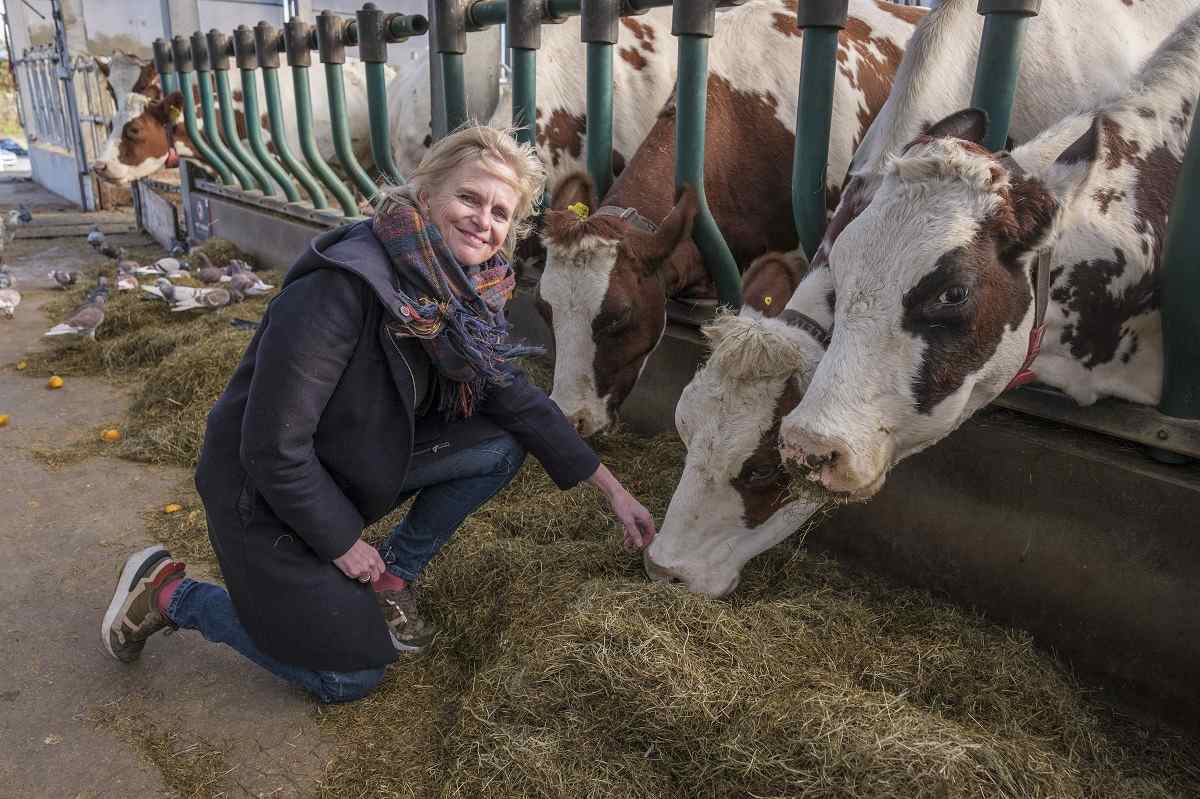Cows in Rotterdam Harbor, Seedlings on Rafts in India; Are Floating Farms the Future?

Minke van Wingerden of the Floating Farm, poses for a photo with some cows at the farm on Nov. 7 2023, in Rotterdam, Netherlands.
11:06 JST, December 11, 2023
ROTTERDAM, Netherlands (AP) — On the top deck of a three-tiered structure moored near downtown Rotterdam, brown and white cows graze on hay dropped from a conveyor belt above their heads and rinds of oranges salvaged from supermarket juice machines in the port city. Canopies overhead protect the cows from sun and collect rainwater they will eventually drink.
Sometimes the Maas-Rijn-Ijssel cows — named for three Dutch rivers — walk over to a machine that automatically milks them, or they shuffle out of the way of a robot trundling past to mop up manure that will be turned into organic fertilizer.
“We call our cows upcycle ladies,” says Minke van Wingerden of the Floating Farm, which sells the milk, cheese and buttermilk produced by the cows in a small shop on dry land next to its harbor berth.
The Floating Farm, which has been operational since 2019 and bills itself as the world’s first such farm, isn’t on entirely new terrain. Efforts to put agriculture on or in the water are as old as the Aztecs, who built artificial islets to grow food long ago in what’s now Mexico.
But it’s an idea that is getting new attention as a way of tackling both food security and the challenges of climate change. And it doesn’t have to be as sophisticated as the Dutch farm, which came about after Van Wingerden’s husband, Peter, witnessed the food shortages that hit New York after Hurricane Sandy slammed the city in 2012.
In coastal and low-lying areas of India and Bangladesh, a non-government organization is reviving a traditional practice of creating floating rafts that can keep seedlings above monsoon flood waters that can drown crops.
The South Asian Forum for Environment, based in Kolkata, has made some technological improvements for what it calls “climate-resilient float farming.” The bamboo rafts are built larger and heavier to better withstand storms. Plastic covering and shade nets protect fragile plants, and solar-powered pumps collect rainwater to irrigate the seedlings. And the organization has partnered with local research institutes to supply farmers with the best possible climate-resilient seeds, and to pass on knowledge about pest control. Communications director Amrita Chatterjee said that can become more urgent when pests proliferate in times of extreme heat, like this summer, where the temperature reached 113 degrees Fahrenheit (45 degrees Celsius) in some locations.
Chatterjee said the rafts are “not a very conventional type of farming” and it takes patience to get used to them. But in a few years they’ve more than doubled, to 500, the number of floating farms operating in different villages. Vegetables like medicinal plants, spinach and chilies are among the items cultivated on the floating platforms, and farmers can also raise crabs to be fattened for market in floating boxes.
“Slowly, everyone is getting interested,” Chatterjee said.
With increasingly erratic monsoons, the rafts have helped with food security, Chatterjee said. They were also helpful when the Indian state of West Bengal was hit with a one-two punch of a cyclone followed by COVID-19 in 2020, she said.
Farmers using the rafts now are feeding themselves and selling a bit of surplus in local markets, Chatterjee said. Her group hopes that the idea can be scaled up to make it much more commercially viable.
Floating farms will clearly be scalable in the coming decades in Southeast Asia, but educating about the technology may be a hurdle to its adoption in some places, said Craig Jenkins, academy professor of sociology at Ohio State University.
Back in Rotterdam, the owners of the Floating Farm cite a number of reasons for putting farms on water. That includes urbanization putting more people in cities, making it sensible to bring food sources closer to them. They say the extreme weather spurred by climate change — heavy rainfall and flooding of cities and farmland — makes their approach climate-adaptive to feed those cities.
Jake Boswell, an associate professor of landscape architecture at Ohio State University, said the success of floating farms likely will vary by region. While much of the world’s population lives in coastal areas, only a subset of those communities also farm in flood- or storm-prone areas, he said. That might make it more cost-effective to invest in floating housing rather than floating farms to adapt to sea level rise, he said.
“The one in Rotterdam I think is an interesting demonstration,” he said. “I would find it hard to see it as a scalable project.”
Scaling up and contributing substantially to the sustainability of urban food systems is a challenge floating farms have in common with vertical farms, said Daniel Petrovics, a Ph.D candidate at the University of Amsterdam who has studied the scaling of several climate interventions, including in the energy and agriculture sectors.
“You should consider things like, what is the local diet, what do people eat? Is this feeding into that? What kind of stakeholders benefit from it?” he said. “Is it that it helps alleviate food poverty in a city or is it just some kind of gimmick that’s from, let’s say, a corporation that’s just looking for return on investment?”
The owners of the Dutch floating farm are already moving to expand beyond their cows.
They plan to add a second floating farm in the same harbor for vertical agriculture — growing vegetables indoors, under lights in stacks of growing beds, irrigated with water purified in part with heat from the cows’ manure.
Minke Van Wingerden sees agriculture on water as a viable response to flooding and rising sea levels and a way of bringing food production closer to consumers, meaning a lower carbon footprint.
“When you have floating farms, you are climate adaptive,” said Van Wingerden. “So you can keep on producing fresh, healthy food for the city.”
"News Services" POPULAR ARTICLE
-

American Playwright Jeremy O. Harris Arrested in Japan on Alleged Drug Smuggling
-

Japan’s Nikkei Stock Average as JGB Yields, Yen Rise on Rate-Hike Bets
-

Japan’s Nikkei Stock Average Licks Wounds after Selloff Sparked by BOJ Hike Bets (UPDATE 1)
-

Japan’s Nikkei Stock Average Buoyed by Stable Yen; SoftBank’s Slide Caps Gains (UPDATE 1)
-

Japanese Bond Yields Zoom, Stocks Slide as Rate Hike Looms
JN ACCESS RANKING
-

Keidanren Chairman Yoshinobu Tsutsui Visits Kashiwazaki-Kariwa Nuclear Power Plant; Inspects New Emergency Safety System
-

Imports of Rare Earths from China Facing Delays, May Be Caused by Deterioration of Japan-China Relations
-

University of Tokyo Professor Discusses Japanese Economic Security in Interview Ahead of Forum
-

Tokyo Economic Security Forum to Hold Inaugural Meeting Amid Tense Global Environment
-

Japan Pulls out of Vietnam Nuclear Project, Complicating Hanoi’s Power Plans

























